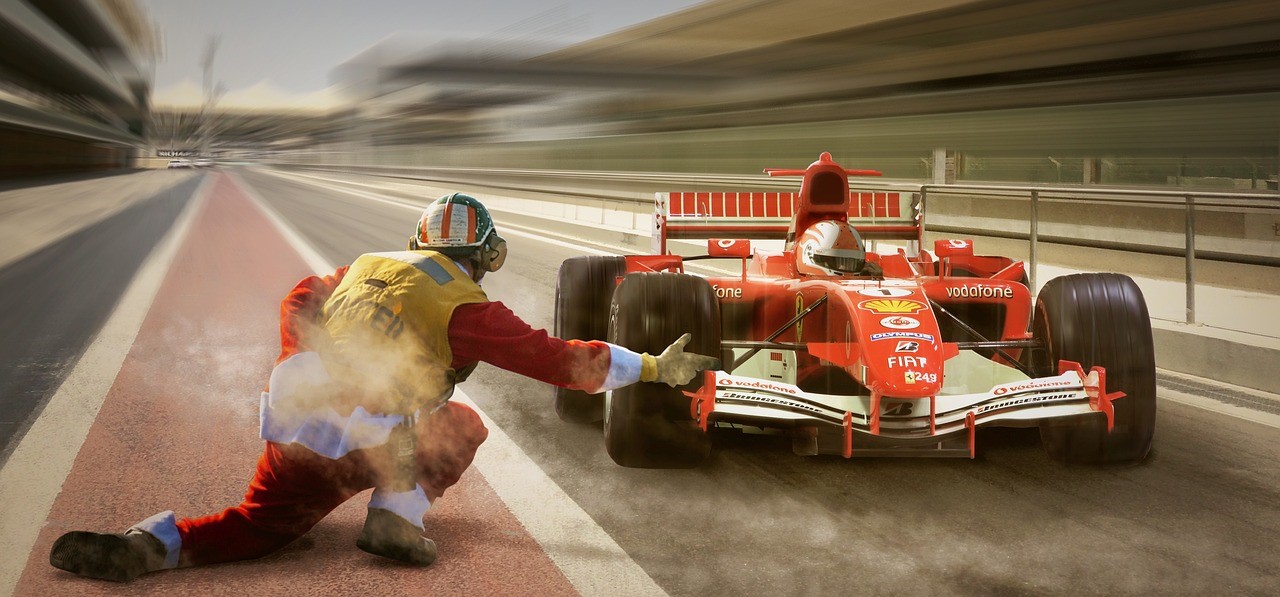Have you ever watched a Formula One race?
Well, if you have, you will already know how exciting an event can be.
The atmosphere is absolutely electrifying. The cars are screaming past at breakneck speed. The drivers are twisting and turning with white-knuckle precision. The air is thick with the smell of hot metal, burnt rubber, and high-octane fuel.
Indeed, this is the razor’s edge of competition. Where you see man and machine work in perfect symbiosis.

Source: Image by Peter Fischer from Pixabay
Growing up in Malaysia, I have certainly watched my fair share of races. The Malaysian Grand Prix was a regular fixture. Drawing elite teams and passionate fans from all over the world:
- For me, one of the most fascinating aspects of any Formula One race are the pit stops. Every time a car peels away from the racetrack and drifts in for maintenance, you know that you’re about to watch pure poetry in motion.
- The instant the car brakes to a stop, the pit crew immediately descend upon it. They work like a well-tuned orchestra. Refuelling the vehicle. Swapping out the tyres. Making rapid-fire adjustments.
- Then — whoosh — the crew completes their task, withdrawing in picture-perfect unison. And the car catapults out from the pit, re-entering the racetrack. It all happens in a blink. Smooth as liquid.
This is always impressive to watch. However, what’s equally impressive is the history of the Formula One pit stop. Here are some interesting facts to consider:
- In 1950, it took around 67 seconds for a crew to service a car.
- By 1965, that time had been shaved down to 45 seconds.
- By 1970, that had been trimmed down even further to 27 seconds.
- By 1980, it had dropped to 11 seconds.
- By 1993, it had dropped to six seconds.
- By 2016, it had dropped to just over two seconds.
- It’s astonishing, isn’t it? Altogether, this represents an improvement of over 96%. It’s a marvel in productivity and efficiency.
- If you want to get a sense of how the pit stop has evolved in recent decades, you can watch this brilliant video clip on YouTube here.

Source: Image by geekasylum from Pixabay
So, this brings me to our fair and lovely land, New Zealand:
- I am intensely patriotic. I do believe this country has enormous potential. I continue to have great faith and enthusiasm for this nation’s future.
- However, I must concede that my feelings are not universally shared. I have observed that many Kiwis have slipped into a psychological black hole lately. Their perception is that our country is not going forward anymore. In fact, it feels like it’s going backward.
- Between the cost-of-living crisis and the culture wars, many people are exhausted. They struggle to look ahead at the next three months, let alone the next three years. They are simply burned out by the emotional rollercoaster that continue to pummel them, day in and day out.
So, what’s the antidote for this negativity? What’s the solution for the depression we find ourselves in? Well, perhaps it’s time to reclaim our ambition, then upsize it quickly:
- At the moment, New Zealand currently has a GDP per capita of around USD $48,000. But I have a bold question to ask. A controversial question. What will it take for this country to double its income to around USD $96,000 as quickly as possible?
- Well, gosh. I can imagine you blinking in disbelief right now. Given the extreme trials that we’ve faced lately, this number seems damn well unachievable, isn’t it? Perhaps even foolhardy?
But hear me out. I am thinking about One Big Idea that have the potential to catapult New Zealand forward:
- It’s about productivity. It’s about efficiency. It’s about common sense.
- But be warned. None of what I’m about to discuss here is politically correct. In fact, it may offend and shock some people if they are overly sensitive about the issue of wealth-building. But I make no apologies for my proposal. Here’s why…
Your first Quantum Wealth Report is waiting for you:
⚡🌎 Start Your Subscription: NZ$37.00 / monthly
⚡🌎 Start Your Subscription: US$24.00 / monthly







John is the Chief Investment Officer at Wealth Morning. His responsibilities include trading, client service, and compliance. He is an experienced investor and portfolio manager, trading both on his own account and assisting with high net-worth clients. In addition to contributing financial and geopolitical articles to this site, John is a bestselling author in his own right. His international thrillers have appeared on the USA Today and Amazon bestseller lists.